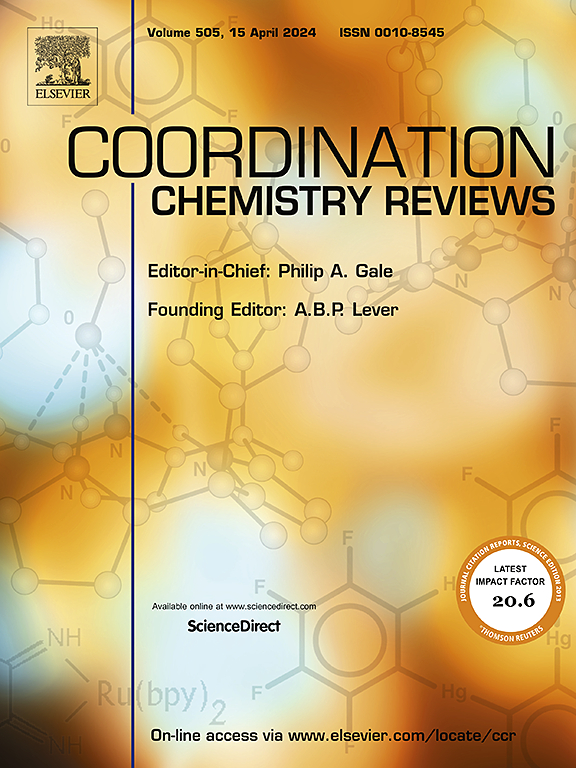用于水分解的二维金属有机框架及其复合材料:催化见解、合成途径和结构工程策略
IF 20.3
1区 化学
Q1 CHEMISTRY, INORGANIC & NUCLEAR
引用次数: 0
摘要
为了应对气候变化和能源不安全的挑战,电化学水分解通过析氢反应(HER)和析氧反应(OER)产生绿色氢能,为实现碳中和提供了一条可持续的能源途径,发挥了关键作用。二维金属有机骨架(2D MOFs)因其独特的结构特性而成为下一代电催化剂,如原子级厚度、丰富的活性位点、高表面积、可调节的孔隙率和灵活的结构调制,这些特性共同提高了电导率、催化活性和长期稳定性。本文从水电解的基本原理开始,系统地总结了基于mof的二维电催化剂在HER、OER和整体水分解方面的最新进展。重点研究了二维mof及其复合材料的先进合成方法,以提高其催化性能,探索了结构工程方法,包括缺陷工程、配体工程和金属节点工程,以优化其电子结构和催化活性,并强调了二维mof与导电材料的集成,以提高导电性、稳定性和整体性能。本文不仅介绍了基于二维MOF的电催化剂的最新进展,而且对未来在可持续能量转换技术中设计高性能二维MOF材料的方向进行了展望。本文章由计算机程序翻译,如有差异,请以英文原文为准。

2D metal-organic frameworks and their composites for water splitting: Catalytic insights, synthesis pathways, and structural engineering strategies
In response to the challenges of climate change and energy insecurity, electrochemical water splitting, which generates green hydrogen energy through the hydrogen evolution reaction (HER) and oxygen evolution reaction (OER), plays a pivotal role in achieving carbon neutrality by offering a sustainable energy pathway. Two-dimensional metal-organic frameworks (2D MOFs) have emerged as next-generation electrocatalysts due to their unique structural properties such as atomic-scale thickness, abundant active sites, high surface area, tunable porosity, and flexible structure modulations, which collectively enhance electrical conductivity, catalytic activity, and long-term stability. This review systematically summarizes recent progress in 2D MOF-based electrocatalysts for HER, OER, and overall water splitting, starting with an overview of the fundamental principles of water electrolysis. It focuses on advanced synthetic methodologies for 2D MOFs and their composites to boost catalytic performance, explores structural engineering approaches, including defect engineering, ligand engineering, and metal node engineering, to optimize their electronic structures and catalytic activity, and highlights the integration of 2D MOFs with conductive materials to improve conductivity, stability, and overall performance. This review not only presents the cutting-edge developments in 2D MOF-based electrocatalysts but also provides insights into future directions for designing high-performance 2D MOF materials in sustainable energy conversion technologies.
求助全文
通过发布文献求助,成功后即可免费获取论文全文。
去求助
来源期刊

Coordination Chemistry Reviews
化学-无机化学与核化学
CiteScore
34.30
自引率
5.30%
发文量
457
审稿时长
54 days
期刊介绍:
Coordination Chemistry Reviews offers rapid publication of review articles on current and significant topics in coordination chemistry, encompassing organometallic, supramolecular, theoretical, and bioinorganic chemistry. It also covers catalysis, materials chemistry, and metal-organic frameworks from a coordination chemistry perspective. Reviews summarize recent developments or discuss specific techniques, welcoming contributions from both established and emerging researchers.
The journal releases special issues on timely subjects, including those featuring contributions from specific regions or conferences. Occasional full-length book articles are also featured. Additionally, special volumes cover annual reviews of main group chemistry, transition metal group chemistry, and organometallic chemistry. These comprehensive reviews are vital resources for those engaged in coordination chemistry, further establishing Coordination Chemistry Reviews as a hub for insightful surveys in inorganic and physical inorganic chemistry.
 求助内容:
求助内容: 应助结果提醒方式:
应助结果提醒方式:


